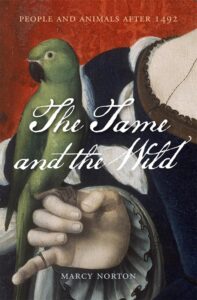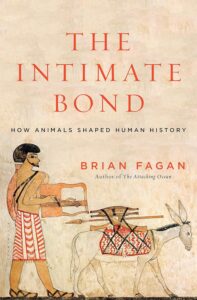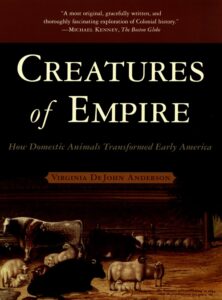The Tame and the Wild: People and Animals After 1492 – Mary Norton.
 The Tame and Wild: People and Animals After 1492. By Mary Norton (Cambridge: Harvard University Press, 2024. pp. 438. Cloth, $37.95.)
The Tame and Wild: People and Animals After 1492. By Mary Norton (Cambridge: Harvard University Press, 2024. pp. 438. Cloth, $37.95.)
There are lots of weaknesses in Brian Fagan’s The Intimate Bond: How Animals Shaped Human History (2014). This book is not about how all animals shaped all of human history – it focuses on domesticated animals, mostly in Europe and North Africa, with a detour into China in one of his many chapters on the horse. So undomesticated animals are excluded from this history, as are animals in the Western Hemisphere, where, yes, there were not as many domesticated animals. However, this not mean that animals in the Western Hemisphere, domestic or not, did not form intimate bonds with the Indigenous peoples of those continents. Fagan makes the mistake of saying:
Now, for the first time [since animals were domesticated], animals became individual property – something to be cherished, valued, and counted – to be given as calculated gifts, not necessarily as currency in the sense we would use the word today, but as part of the equation of survival and wealth accumulation that became central to human life in ways unimaginable among hunters and foragers (67).
This is where Mary Norton’s The Tame and the Wild comes in to undercut Fagan’s myopic vision of human-animal relationships by demonstrating that hunter-gatherer societies in the Americas did, in fact, have intimate bonds with the animals around them. They may not have domesticated them, but they did engage in a process that Norton calls familiarization:
Familiarization differs from domestication in that familiarized animals were not bred in captivity – at least before encounters with Europeans – but rather animals found or captured in the wild…these pithy definitions underscore a bond between tamer and tamed, organized most fundamentally around the nurturing relationship of the feeder and the fed (131).
Further:
If predation is the process by which one pursues and consumes another being, familiarization – or feeding and therefore taming – is how one turns a wild being into kin (132).
To familiarize an animals was to tame it, to acclimate it to human interaction and mutual dependency. Indigenous Peoples of the Americas used familiarization to tame wild animals and incorporate them into society for a variety of uses, including acting as hunting partners, or as pets. As Norton explains, Indigenous Peoples would not prey among animals they fed, they would only consume wild animals that they had not familiarized. To Europeans used to raising livestock to a kill and eat, this refusal to eat the flesh of those they fed was foreign, strange, and, as defined by the European relationship between livestock and their owners, uncivilized.
 Chapter by chapter, Norton refutes the argument that because the Americas did not have a proliferation of animals able to be domesticated, that Indigenous peoples only had relationships to animals that involve hunting and killing them. One of the most useful examples of this is the way Indigenous Peoples would tame parrots or monkeys, making gifts of them to Europeans. Indigenous Peoples also approached initial encounters with European animals as one of familiarization, and built relationships with animals like horses and pigs based on taming instead of domesticating. Virginia DeJohn Anderson has written extensively on the role of European domesticated animals in the colonization of North America in Creatures of Empire. The Tame and the Wild is the Central and South American corollary to Anderson’s work.
Chapter by chapter, Norton refutes the argument that because the Americas did not have a proliferation of animals able to be domesticated, that Indigenous peoples only had relationships to animals that involve hunting and killing them. One of the most useful examples of this is the way Indigenous Peoples would tame parrots or monkeys, making gifts of them to Europeans. Indigenous Peoples also approached initial encounters with European animals as one of familiarization, and built relationships with animals like horses and pigs based on taming instead of domesticating. Virginia DeJohn Anderson has written extensively on the role of European domesticated animals in the colonization of North America in Creatures of Empire. The Tame and the Wild is the Central and South American corollary to Anderson’s work.
Norton makes a powerful argument when introducing the idea of familiarization vs. domestication, and I want to include it here in its entirety, because it is what made this book really stand out for me:
The scattered and fragmentary nature of the sources touching on early modern taming practices is the primary reason why this study employs capacious geographical and temporal parameters. The lack of attention paid to the history of familiarization is also rooted in the fact that scholars – among them Jared Diamond – have misleadingly interpreted taming practices through the teleological lens of domestication. In other words, they have assumed taming wild animals was a “stepping stone” to “full” domestication. By aggregating fragmentary traces and avoiding a teleological view of domestication, the importance and complexity of familiarization as a mode of interaction can come into view (132).
In this argument, Norton reveals that we still view animal-human relationships through the lens of European colonists. The colonization argument claims that domestication of animals is not just concomitant with the rise of Western “civilization,” it is a prerequisite for it. The West’s contemporary scholars can write about Indigenous People’s relationships with the animals they hunted because this human-animal relationship was familiar to them, even though the way Indigenous people’s viewed and carried out hunting diverged sharply from how Europeans approached it. Other Indigenous relationships with animals have been erased from history because they simply do not conform with how Europeans/Westerners understand the “proper” relationship between humans and animals. Familiarization is not domestication, and this means that Indigenous People’s lose their identities to the tellers of the dominant narrative of human-animal relationships and therefore civilization.
Norton’s arguments and the evidence she presents are much more eloquent and informative than the summary I have given here. Her research refutes the Euro-centrism of Fagan’s writing, and even of Anderson’s, though it also fits nicely with Anderson in providing a counternarrative to Anderson’s focus. The two books can work together, even as Norton carves a new and important place for her scholarship. By uncovering the process of familiarization in the way Indigenous Peoples approached the animals around them, Norton gives us a new understanding of the history of how human and animals have interacted over time, the fact that these animals and humans in the Americas did have intimate bonds prior to European contact, even if these animals weren’t domesticated. European colonization ripped at these bonds and forced domesticated animals on the Indigenous Peoples, even if they still did find ways to incorporate animals into their own cultural understanding, much to the chagrin of their colonizers.
How people interacted with animals was important culturally, socially, and politically. It defined who was civilized and who was not, who fit in and who didn’t, who had and who lacked power. Norton’s work fills a historical vacuum, demonstrating how to research and write a history of a topic that has been aggressively forgotten, even to the current day.
